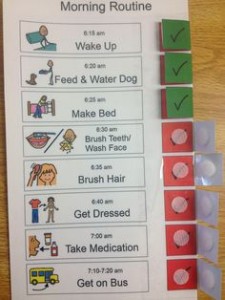Better routines begin with children learning how time can be organised and then using tools to implement them.
Preschool and early school classrooms make great use of clocks and calendars: changing the hands, showing days of the week, month, season, even monitoring the weather. Most schools also use visual and auditory timers like bells to mark time during the day. As children mature and are expected to take on more responsibilities for their own time management, planners and to-do lists become extremely beneficial.
You can help children become more independent with their routines through the use of clocks, timers, calendars and planners to help teach them the concept of time and sequencing in everyday life. You can try:
- Having clocks where they can be clearly seen and referred to during the day. Analog clocks are better than digital clocks as they show that time moves (with the movement of the hands).
- Making a visual timeline for the day at home and school, marking each event with a picture of the hands on the clock at that time and the time written numerically.
- Encouraging the use of a watch if you child is willing to wear one. Again analog is preferred as your child can see time moving.

- Practising telling the time with your child in different ways, e.g. “six thirty”, “half past six”
- Using count-down visual and/or auditory timers for specific tasks eg sand timers or the ‘time timer’ app. You can make this fun by playing “beat the bell” where your child has to complete their task before the timer ends.Using calendars to organise family life and after school activities. Calendars can make great use of visual learning (seeing a record of events), auditory learning (talking about the events that have happened or are coming up), and kinesthetic learning (writing down events or crossing them off when done).
- Using daily or weekly to-do lists or planners. At the end of each day, encourage your child to cross off activities from that day, then discuss activities involved in the next day.
 Remember time is an abstract concept – we can’t actually touch or see it. Using calendars, planners, and lists makes time more tangible by highlighting events and activities which your child can personally relate to.
Remember time is an abstract concept – we can’t actually touch or see it. Using calendars, planners, and lists makes time more tangible by highlighting events and activities which your child can personally relate to.
Promote your child’s sense of responsibility by encouraging them to refer to the calendar or planner rather than relying on you to tell them what is happening each day.
